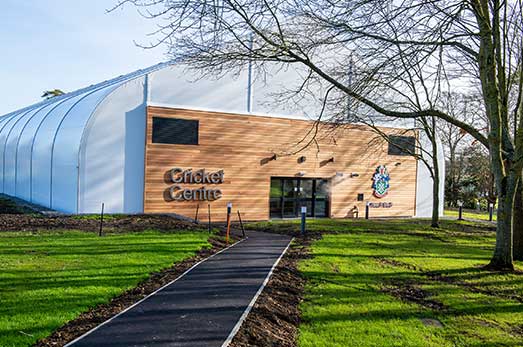Blog
27th October 2020

There’s such a buzz right now around off-site manufacturing and this month, I wanted to highlight both the advantages of this way of working and dispel some of the common myths surrounding structures built with this method. So with that in mind, I’m handing this month’s blog over to Nigel Marcoolyn, Director of Architecture at Cowan Architects. We’ve worked together on many Sprung structure projects and, most recently, we’ve collaborated on the Swim England feasibility report. As he explains, we’ve seen the incredible results you can achieve through off-site manufacturing first hand, but some people still need convincing. Nigel, it’s over to you…
Advocates of off-site manufacturing (and I put myself firmly in that bracket) certainly have their work cut out in convincing some parties.
Bad memories of post-war prefab housing and draughty portakabin classrooms are causing many of those from older generations commissioning new builds to reject modular construction in favour of a more traditional approach.
Suffice to say, resistance to the off-site manufacturing/modular concept remains high.
Which is a shame. Because off-site manufacturing brings with it a wide range of benefits and provides an answer to many of the challenges facing the construction industry today. From reducing build delays and budget overruns, to boosting productivity and promoting a more collaborative approach to projects, there’s a lot to gain.
After decades in the shadows, advances in technology have placed off-site manufacturing back in the spotlight. So much so, that every major review of UK construction since the 90s has recommended its adoption. Which leaves myself, Matt and many others wondering why less than 5% of all UK new builds choose off-site manufacturing.
Benefits of off-site manufacturing
The reality is that many of the challenges faced by the construction industry are rooted in the on-site environment – from the limited opportunities for automation to the UK’s unpredictable weather.
Luckily, there is an alternative.
A survey by the ECA, CIBSE and SELECT found that off-site construction is faster, greener, safer and cheaper. Let’s look at those key benefits in more detail.
1 Faster: Time-saving advantages
One of the most notable benefits of off-site manufacturing is the time it can save. Rather than all the building taking place on site, around 50-75% can take place elsewhere (generally in a warehouse).
According to data from the National Audit Office, off-site manufacturing could reduce build times by up to 50% – offering huge commercial benefits and reducing disruption. See for yourself on the time lapse video capturing the construction of Millfield School’s Golf Centre – shot over 14 days.
2 Greener: Eco-friendly credentials
Off-site manufacturing is also more environmentally-friendly than traditional construction processes. While some new buildings require hundreds of vehicle loads of materials to be brought on site, a modular build may only need two or three containers. As well as slashing transport costs and on-site traffic, it also reduces pollution.
And let’s not forget the structure itself. Paragon Structures’ tension fabric buildings have an R-25 to R-30 energy efficiency rating, in excess of Building Regulations Part L, with an air-tightness of up to 2.0, which is five times better than building regulations. They also use an aluminium frame, which is fully recyclable and can be pulled apart and rebuilt elsewhere, if needed.
3 Safer: Fewer people required on site
At a time when Covid-19 remains part of our lives and social distancing is the norm, the fewer people required on a project site at any one time, the better. In a traditional build, a project might require between 20 and 30 people to be on the site at any one time. When using off-site manufacturing, that figure can be as low as seven.
What’s more, these structures are built in warm, dry, safer environments (yes, back to those warehouses again) and much of the work is automated. Which means fewer accidents and injuries.
4 Cost-effective: That all-important budget
The survey mentioned above used the word ‘cheaper’, but I’d go with off-site construction being ‘more cost-effective’. It’s true that rather than having a contractor on-site for an entire year, they might only be there for three or four months, which will save money on prelims, overheads and profits. But when you weigh up the time saved (in particular in a live environment), disruption avoided, safer working conditions and eco credentials gained from off-site manufacturing, the project instantly becomes more economical and productive.
Working with off-site manufactured buildings does bring some challenges – and I’m not just talking about the resistance that Matt and I come up against when discussing this type of building.
One of those challenges is the look of the building itself. They can resemble big tops (and not everyone wants the circus in town). However, with the addition of innovative and attractive architectural features like timber cladding, and by lowering the building into the ground, you can alter the appearance dramatically.
I urge education and leisure industry leaders to take a look at Paragon’s most recent projects to see the standard of solution that can be achieved. Once people see what’s on offer, they realise the kind of buildings that are well within their grasp.
Thanks Nigel. Our mission here at Paragon Structures is to remove barriers to physical activity. Off-site manufacturing can help us overcome many of the hurdles associated with building modern, cost-effective sports facilities. To see how our solutions might work for you, drop me a line today.